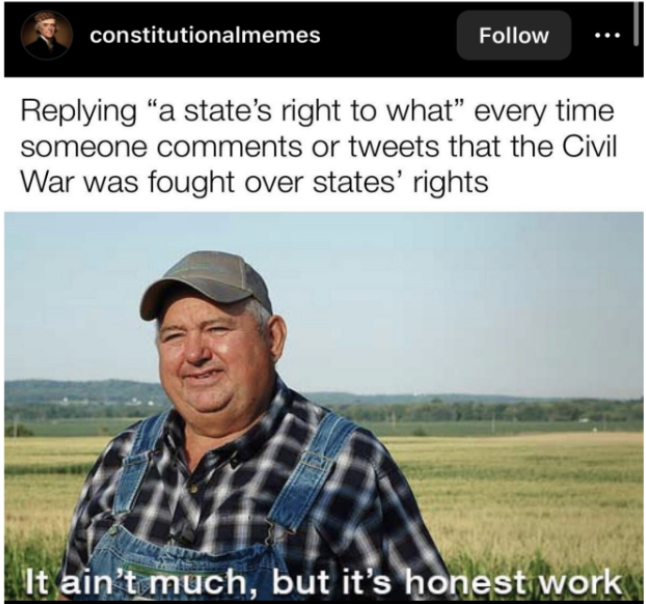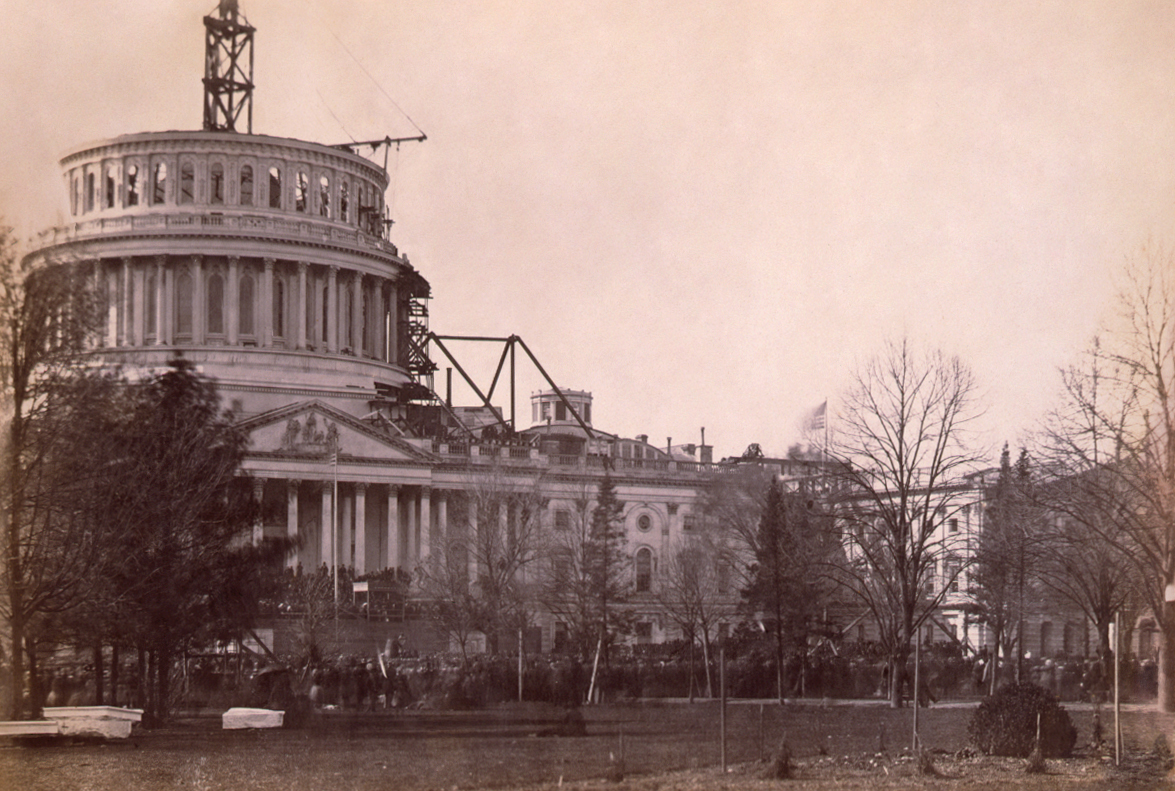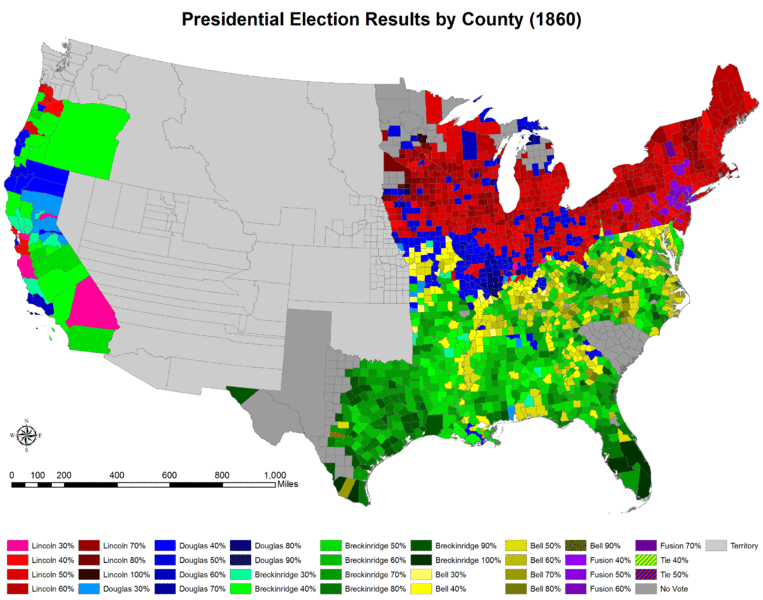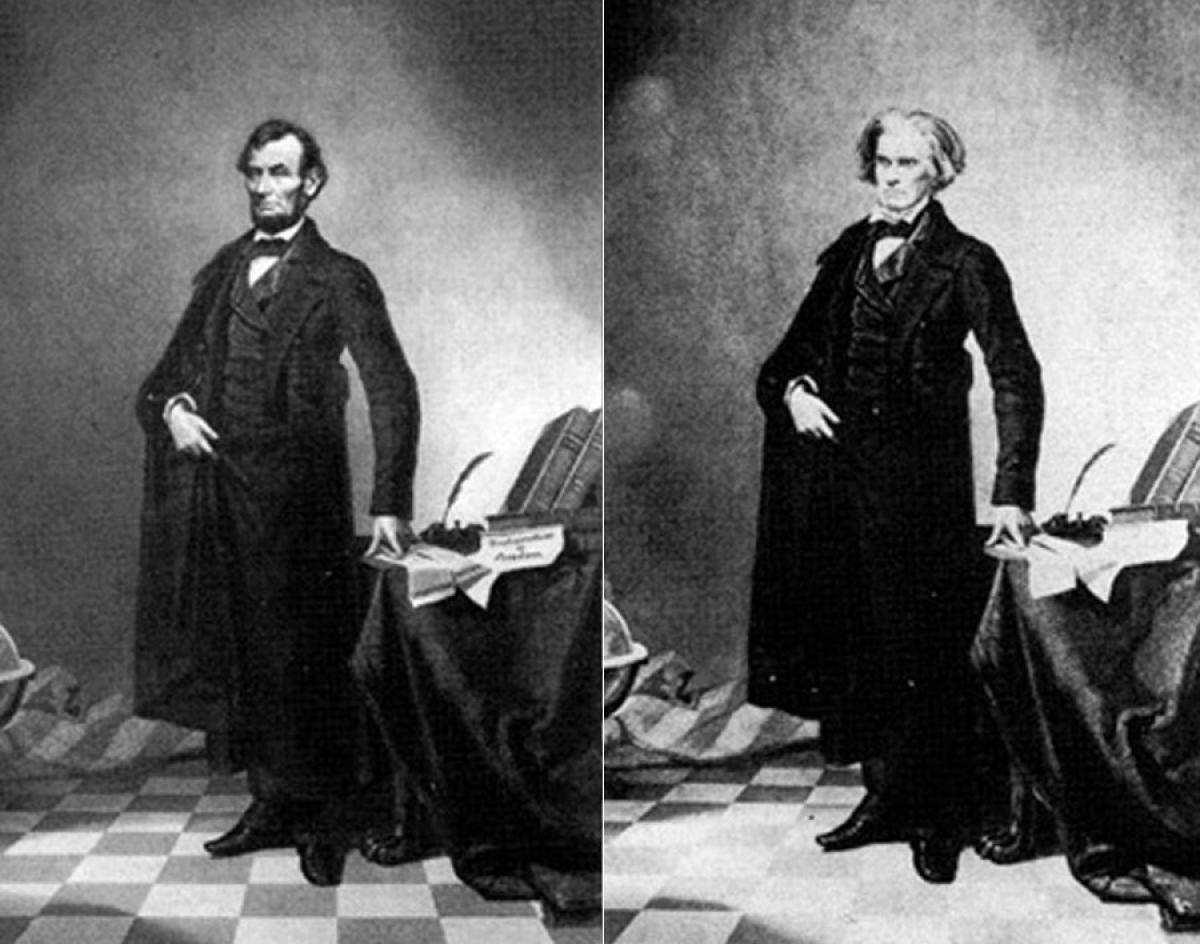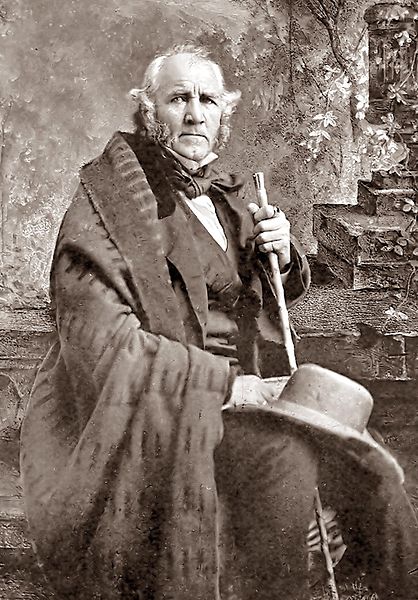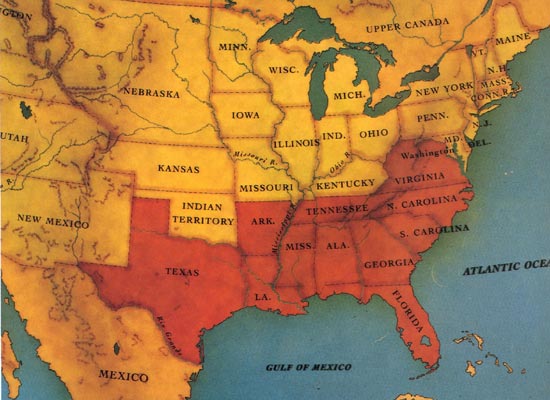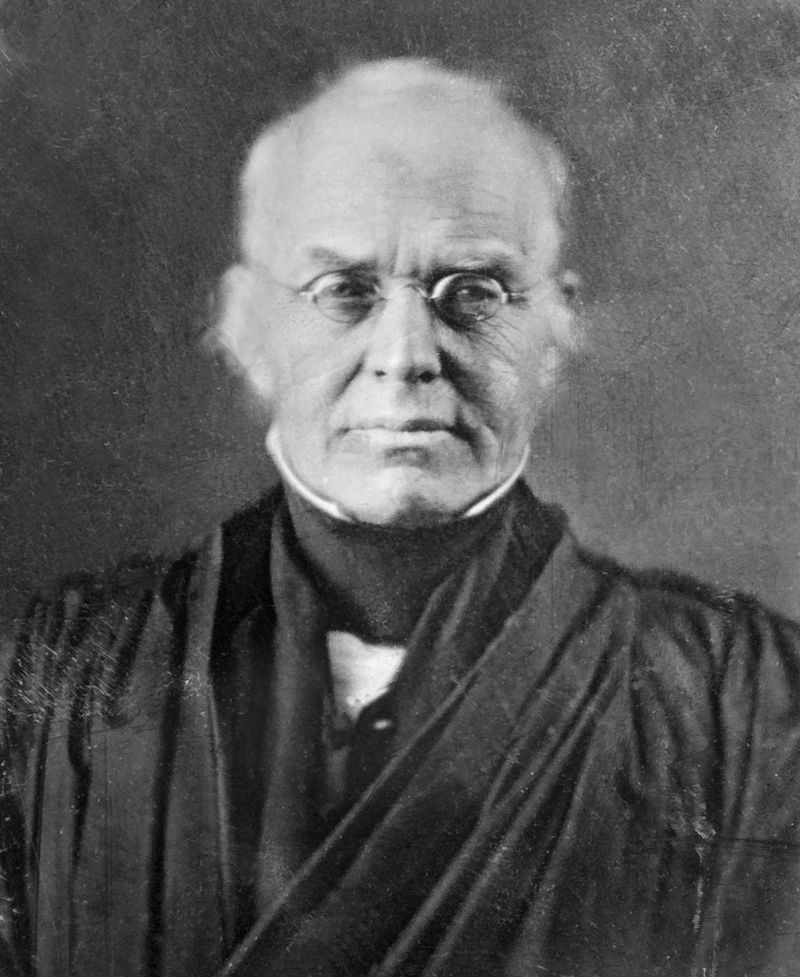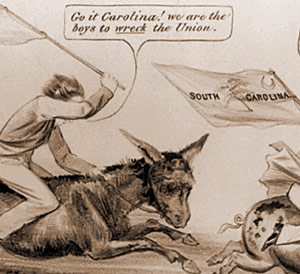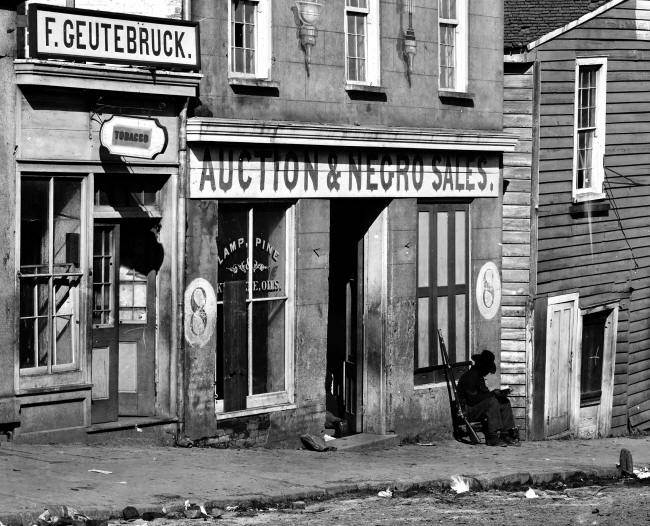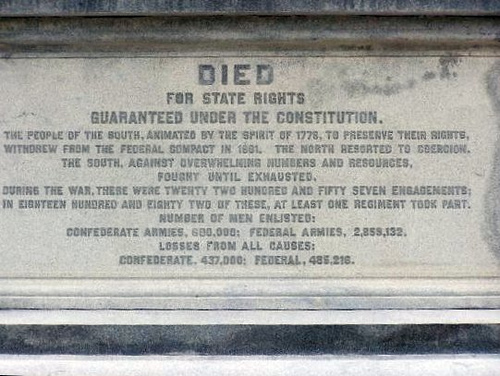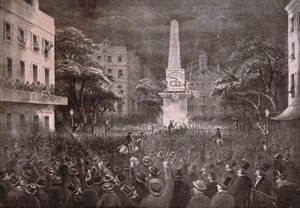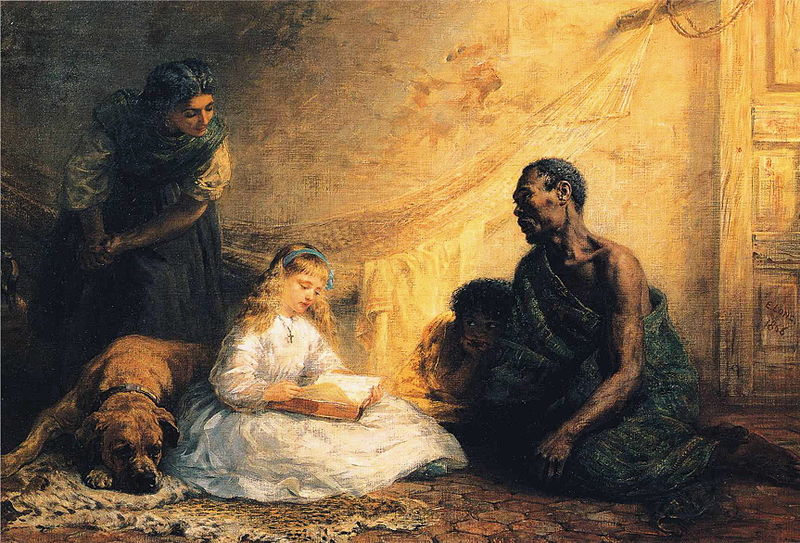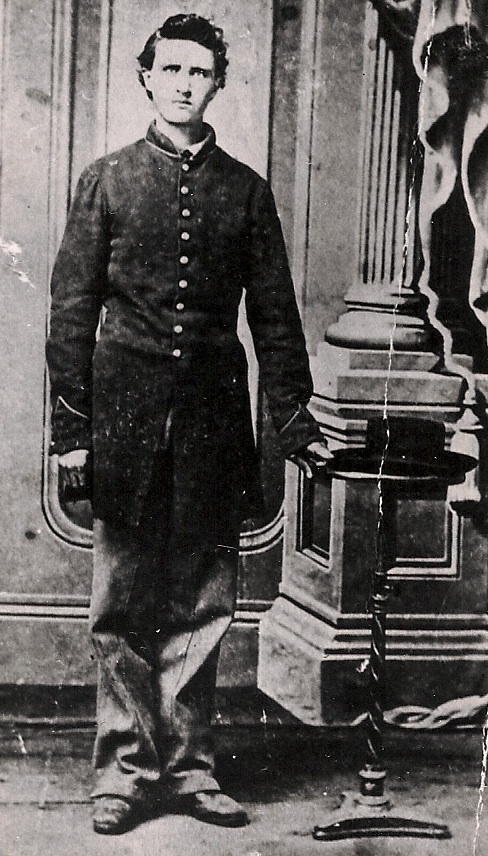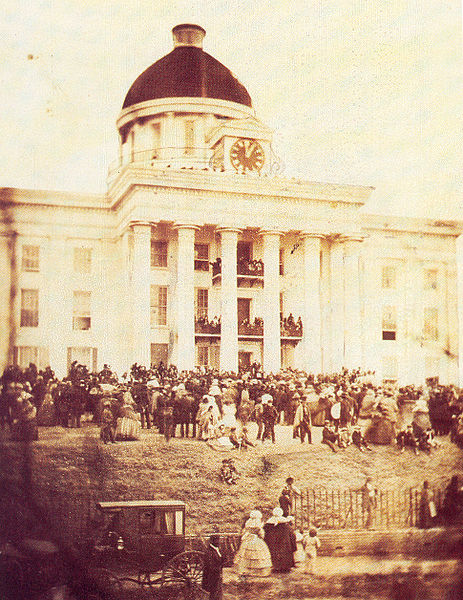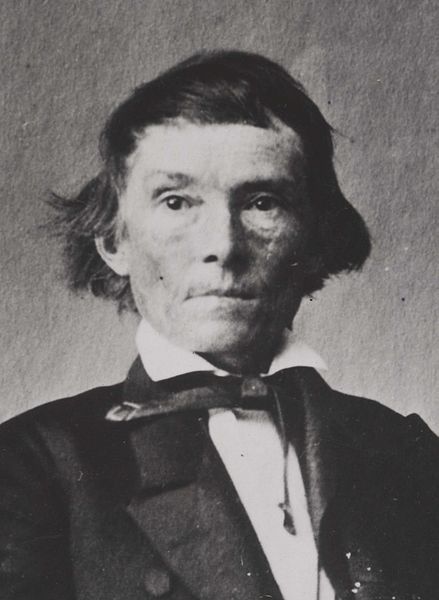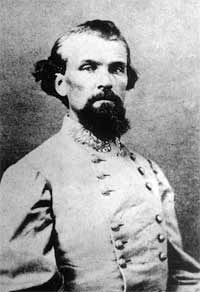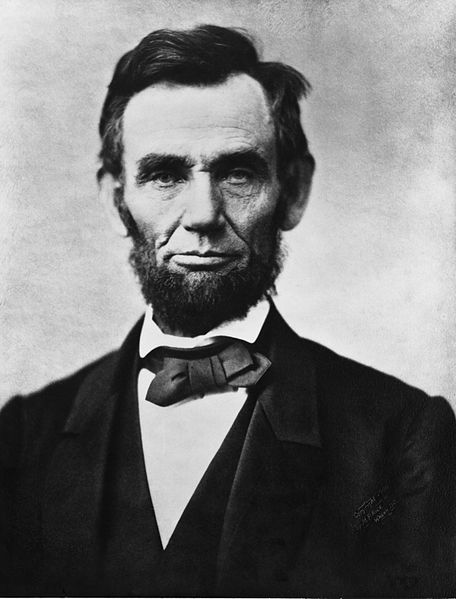She was received as a commonwealth holding [annexed to U.S. in 1845], maintaining and protecting the institution known as negro slavery–the servitude of the African to the white race within her limits–a relation that had existed from the first settlement of her wilderness by the white race, and which her people intended should exist in all future time. — Texas Declaration of Causes [of Secession from the U.S.], 1861
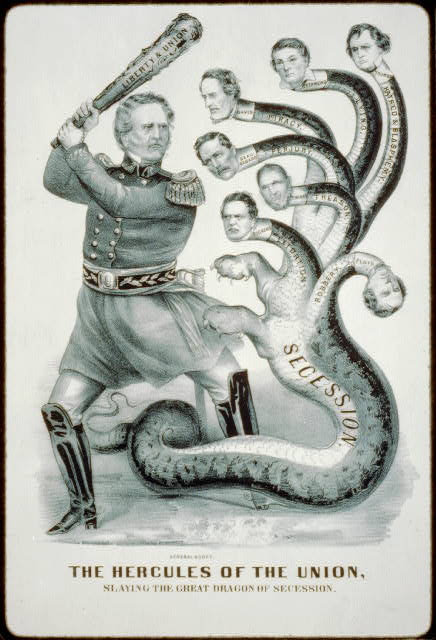
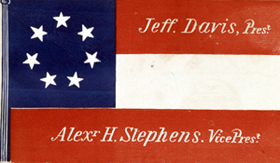 The time between Abraham Lincoln’s election in November 1860 and inauguration in March 1861 is called Secession Winter, when the Confederacy of eleven southern states broke away from the United States. The 1860 U.S. presidential election was a four-horse race, with Lincoln running as a Republican, John C. Breckinridge as a southern Democrat who initially opposed secession (the cousin, amazingly enough, of Lincoln’s wife Mary Todd Lincoln), and two compromise candidates from border states: northern Democrat Stephen Douglas of Illinois and John Bell of Tennessee. The election hinged almost entirely on the question of slavery’s expansion into the western territories. Bell mostly ignored the thornier politics of slavery while promoting union. Douglas continued to promote the right of western territories to decide slavery on their own through free sovereignty, but the “Little Giant” got virtually no votes in the South after the Democrats split up along regional lines during their summer conventions in Charleston and Baltimore. Lincoln continued, officially at least, to support southeastern slavery while blocking its western expansion. He would outlaw slavery in the western territories just as Thomas Jefferson had suggested for the Northwest Territories in 1787, even if that happened under the Articles of Confederation rather than the Constitution. The Capitol Dome was under construction during Lincoln’s inaugural. The project symbolically stalled because Jefferson Davis, the Mississippi Senator in charge, was instead presiding over the Confederacy.
The time between Abraham Lincoln’s election in November 1860 and inauguration in March 1861 is called Secession Winter, when the Confederacy of eleven southern states broke away from the United States. The 1860 U.S. presidential election was a four-horse race, with Lincoln running as a Republican, John C. Breckinridge as a southern Democrat who initially opposed secession (the cousin, amazingly enough, of Lincoln’s wife Mary Todd Lincoln), and two compromise candidates from border states: northern Democrat Stephen Douglas of Illinois and John Bell of Tennessee. The election hinged almost entirely on the question of slavery’s expansion into the western territories. Bell mostly ignored the thornier politics of slavery while promoting union. Douglas continued to promote the right of western territories to decide slavery on their own through free sovereignty, but the “Little Giant” got virtually no votes in the South after the Democrats split up along regional lines during their summer conventions in Charleston and Baltimore. Lincoln continued, officially at least, to support southeastern slavery while blocking its western expansion. He would outlaw slavery in the western territories just as Thomas Jefferson had suggested for the Northwest Territories in 1787, even if that happened under the Articles of Confederation rather than the Constitution. The Capitol Dome was under construction during Lincoln’s inaugural. The project symbolically stalled because Jefferson Davis, the Mississippi Senator in charge, was instead presiding over the Confederacy.
Lincoln won a plurality of the popular vote (39.8%) and a majority of the electoral votes. That was one of the reasons for Lincoln’s unsympathetic views toward secession. Since he’d won by the agreed-upon rules, he asked what gave an entire region the right to pack its bags and leave. If one region left after this election, then maybe another might leave in a huff the next time (e.g. the Midwest or Northeast), and soon the United States would cease to exist. He wouldn’t allow that, regardless of the constitutional legalities of blocking secession.
Most people expected the Republican’s leader, William Seward, to be the GOP candidate in 1860, but delegates hoped that Lincoln being from Illinois would help him secure the lower North, and maybe garner a few upper southern votes because he was born in Kentucky. But Lincoln threatened slavery’s territorial expansion and he got no electoral votes south of the Ohio River, despite some votes in the Upper South. Lincoln wasn’t even on the ballot in many southern states and received only 1.1% of the popular vote south of the Ohio River. Over 60% of Americans voted against Lincoln, making him the least popular winner in U.S. history. The 1860 election was the most regionalized in history. Lincoln’s hostility to western slavery was the source of the problem and the deciding factor that led the first seven southern states to secede. After Lincoln called on volunteers to subdue their rebellion, four more border states left the U.S. to join the new Confederacy (dark green below). John Breckinridge tried to steer Kentucky toward neutrality, but reluctantly gave up and joined the Confederacy, for whom he fought and later served as Secretary of War.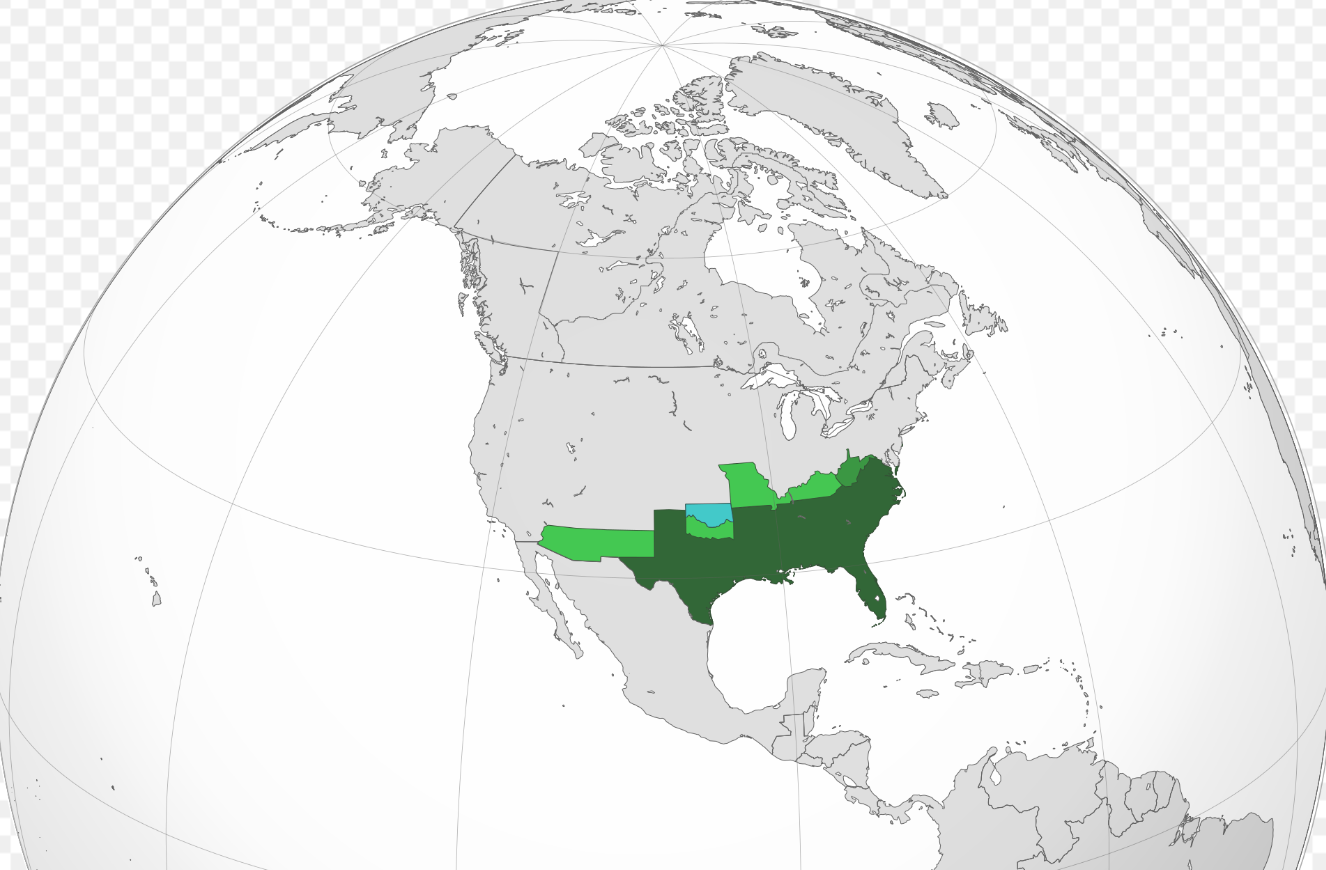
Seward disrespected Lincoln, thinking he was a hick, but the new president was magnanimous enough to hire him anyway and make him Secretary of State, because he thought it gave the Union the best chance of surviving. He co-opted other rivals and critics as well, absorbing their advice and eventually winning them over. Democrat Stephen Douglas also sided with Lincoln after secession. At first, the Republicans expected Lincoln to be a figurehead while better-known operatives like Seward and Salmon Chase ran things behind the scenes, but they underestimated his political prowess. He clarified his policies as soon as he was elected because the sitting president, pro-slavery northern Democrat James Buchanan, just wanted to ride out his term. When Lincoln finally made his way from Illinois to Washington by train, security had to use doubles and switch him from car to car to avoid assassination. Death threats poured in by the thousands from the day he was elected, some with bullets and poisoned ink, and one with a dumpling full of spiders.
 The Washington press derided Lincoln for covering himself with a woman’s shawl and a soft wool cap during the train transfer in Baltimore, but there were indeed people there trying to assassinate him, including a Corsican immigrant hairdresser named Cipriano Ferrandini (left). Ferrandini arranged to have eight fellow “patriots” kill him on the same night, with each thinking he alone had been awarded the honor. The Philadelphia, Wilmington & Baltimore Railroad hired Allan Pinkerton, who founded the Pinkerton National Detective Agency, to protect Lincoln. Pinkerton’s first female detective, Kate Warne, went undercover as a Confederate sympathizer to foil the Baltimore Plot, stopping Ferrandini from “liberating the nation from the foul presence of the abolitionist leader.” They whisked Lincoln through town a day earlier than scheduled in a carriage and unlit passenger car amidst an elaborate series of bluffs and blinds. They gave a lot of attention to one box large enough to hide him in, making sure the railroad workers knew it was vitally important, and that it absolutely had to make it through to Washington that night. Inside assassins found a stack of unimportant papers. Lincoln skipped his scheduled stop in Harrisburg, Pennsylvania, leaving Mary Todd and the kids to face a disappointed crowd. To keep word of his absence from reaching Baltimore, Pinkerton’s men cut the telegraph wire. Had Maryland chosen to secede, which they were considering at the time, the president-elect would’ve steamed through the Confederacy on his way to Washington. For Lincoln, just showing up for work the first day was a major accomplishment.
The Washington press derided Lincoln for covering himself with a woman’s shawl and a soft wool cap during the train transfer in Baltimore, but there were indeed people there trying to assassinate him, including a Corsican immigrant hairdresser named Cipriano Ferrandini (left). Ferrandini arranged to have eight fellow “patriots” kill him on the same night, with each thinking he alone had been awarded the honor. The Philadelphia, Wilmington & Baltimore Railroad hired Allan Pinkerton, who founded the Pinkerton National Detective Agency, to protect Lincoln. Pinkerton’s first female detective, Kate Warne, went undercover as a Confederate sympathizer to foil the Baltimore Plot, stopping Ferrandini from “liberating the nation from the foul presence of the abolitionist leader.” They whisked Lincoln through town a day earlier than scheduled in a carriage and unlit passenger car amidst an elaborate series of bluffs and blinds. They gave a lot of attention to one box large enough to hide him in, making sure the railroad workers knew it was vitally important, and that it absolutely had to make it through to Washington that night. Inside assassins found a stack of unimportant papers. Lincoln skipped his scheduled stop in Harrisburg, Pennsylvania, leaving Mary Todd and the kids to face a disappointed crowd. To keep word of his absence from reaching Baltimore, Pinkerton’s men cut the telegraph wire. Had Maryland chosen to secede, which they were considering at the time, the president-elect would’ve steamed through the Confederacy on his way to Washington. For Lincoln, just showing up for work the first day was a major accomplishment.
Criticism about the shawl was a rude awakening, but Lincoln didn’t let the Washington press shape his image or dictate his agenda any more than he did GOP leadership. Like Ben Franklin, he could kick up his heels and play the frontiersmen whenever it suited him, spitting tobacco as he spun yarns, told off-color jokes or bragged about his 299-1 record in backwoods wrestling matches (he’s in the National Wrestling Hall of Fame), but Lincoln was no simple country bumpkin. He kept educated audiences riveted, as he did in his Right Makes Might Cooper Union Speech in New York that helped him seal the nomination and he gave away counterfeit tickets to the Republican convention to pack the hall with his supporters. The “Rail-splitter of the West” was skilled in the art of self-promotion. He made ample use of studios and, long before Photoshop®, had photographers airbrush out skin blemishes before shipping his portraits to the highest-circulation newspapers (those with steam-powered presses). Since Lincoln was thin, artists often superimposed his head on the bodies of other politicians — in one ironic case over the torso of the South’s most famous defender of slavery: John C. Calhoun.
One young girl from Buffalo, New York wrote the nominee a letter, saying he should cover his homely face. He took her advice and grew a beard and when his inaugural train stopped through Buffalo months later, Lincoln called the girl up on stage and told the humorous story. In Washington, he seized the initiative with the media by establishing his own press corps, pioneering a tradition that formalized in 1914 and continues to this day.
Secession & the Constitution
Lincoln needed all the help he could get because he was facing the stiffest challenge of any president in American history. He would likely be either the country’s greatest president or its last. South Carolina led the charge against him, just as they had against Britain in 1776 when they were one of the first colonies to declare independence, before Continental Congress did. Ironically, South Carolinian Charles Pinckney had pushed the idea of putting the military in the national government’s hands rather than the states’ at the Constitutional Convention in 1787. That mattered now, more than ever. Mississippi exited next, which put pressure on Georgia and Florida in between South Carolina and Mississippi. The original Confederacy was the deep southern states stretching to Texas, where a spirited debate ensued among slave-holding cotton planters from the eastern part of the state and German immigrants in central Texas who believed in doing their own work. In Comfort, Texas stands the “Treue der Union” monument (transl. “loyalty to the union”) honoring 30 German-Americans slain by Confederates in the 1862 Nueces Massacre. Governor Sam Houston opposed secession on unionist grounds and Travis County voted 704-450 against secession. East Texas disagreed, though, and when Texas seceded, that made for seven Confederate states. Four more upper southern states – Arkansas, Tennessee, Virginia, and North Carolina – seceded after Lincoln took office and requested volunteers to help subdue the first seven. By then the Civil War had started with the Confederate attack on Fort Sumter, South Carolina (next chapter). The Union barely held on to four slaves states: Missouri, Kentucky, Maryland, and Delaware.
The immediate Constitutional matter was whether states had the right to leave the United States. Was the Union a voluntary compact, as South Carolina argued, or a permanent alliance as Lincoln proposed? The Constitution itself is ambiguous on the matter, perhaps since some Founders either presumed it wouldn’t happen or that anyone who wanted to leave wouldn’t care what the Constitution said. Article I, Section 10 says that states cannot “enter into treaties, alliances, or confederations” or have armies (keep troops), and Article I, Section 8 says that states cannot raise militias except as prescribed by Congress, tempering the Second Amendment. James Madison, a primary author of the Constitution, wrote that secession was just another name for revolution, “about which there is no theoretic controversy.” Yet, he also rejected a proposal permitting the national government to suppress seceding states. In his convention minutes, Madison wrote: “A union of the states containing such an ingredient (would) provide for its own destruction. The use of force against a state would look more like a declaration of war than an infliction of punishment and would probably be considered by the party attacked as a dissolution of all previous compacts by which it might be bound.” Historian Kevin Gutzman argued that, in Virginia’s case at least (Madison’s home state), their ratifiers understood the Constitution as a revocable agreement among sovereign states when they signed on in 1788. The ratification documents of two northern states, New York and Rhode Island, also expressed their understanding that they could dissolve their union with the United States. In Gutzman’s view, states were free to leave the union. There were some Southerners who either disagreed or wanted to clarify things further in 1860, though, because they tried to pass Constitutional amendments to allow for secession. Other amendment proposals included a three-headed presidency with at least one Southerner permanently among the three and all three having veto power.
Prior to the Civil War, there was as much states’ rights and secession noise in the North as in the South. Some New Englanders considered secession during the War of 1812 and some abolitionists discussed it in the 1850s. There was even talk at the height of the sectional crisis of a “central confederacy” composed of upper southern and lower northern states. Massachusetts exercised states’ rights when it, in effect, nullified the Fugitive Slave Clause in the mid-1850s. To be fair, South Carolina made it clear at the founding in 1776 and again at the Constitutional Convention in 1787 that they had no interest in being in the country if it prohibited slavery. Yet, Lincoln’s election arguably didn’t pose an immediate threat to slavery in South Carolina.
Lincoln just wanted to keep the country together, regardless of what the Constitution said about secession. While it’s clear that he didn’t like slavery and was taking an unwavering stand against its expansion, he was willing to compromise and allow it to exist in the South. Lincoln believed the Constitution granted existing states the right to maintain slavery. Several times during the election season and Secession Winter, Senator John J. Crittenden tried and failed to get an amendment passed permanently shoring up the legality of southeastern slavery — a proposal Lincoln fully supported, though he and the GOP opposed the portion of the Crittenden Compromise reinstating the old 36°30′ Missouri Compromise Line out west. The president-elect thought secession was a bluff and that the South just wanted slavery protected along with better enforcement of the Fugitive Slave Act. Lincoln reiterated his support for this “unamendable” amendment forever preserving southeastern slavery in his First Inaugural Address. Congress passed the amendment, in fact, but the states never ratified it. Ironically, given what we know about later events, that would’ve been the same 13th number used for the amendment that abolished slavery in 1865. President Buchanan also supported such a measure. The 1861 lithograph below lampoons Buchanan for not taking a firmer stance in the sectional crisis. The reason many historians rank him as one of the worst presidents of all time was his inability to act or take any meaningful stance on the biggest crisis in American history. As we saw in previous chapters, he tried to wiggle out of it by shoving the problem onto the Supreme Court or uniting North and South against a common Mormon enemy, but neither worked. The temperamentally unqualified chief executive was caught like the proverbial “deer in the headlights.” Buchanan opposed secession yet denied the Union’s right to stop secession. In his defense, we’ve likely had many presidents that would’ve been in over their heads with the sectional crisis and not known what to do, especially if they prioritized avoiding war or honoring Madison’s original intent on allowing secession. Either way, Lincoln backed Buchanan’s efforts to permanently legalize slavery in the Southeast. Lincoln probably wouldn’t have supported the pro-slavery amendment if he wasn’t prepared to accept the consequences, which is why black abolitionist Frederick Douglass temporarily lost hope in him. 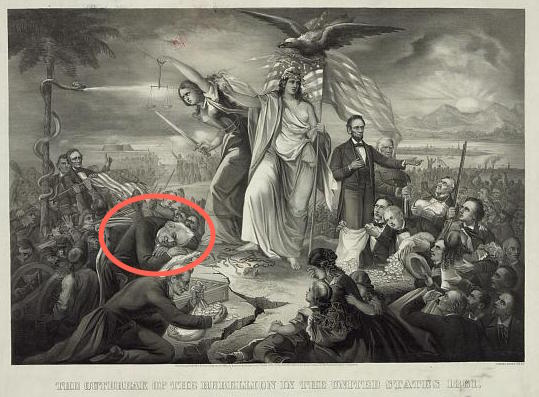
However, the South, or at least certain vocal and influential politicians who claimed to speak for the entire region, wanted no such deal. They saw no daylight between Lincoln’s opposition to expanding slavery and his willingness to acquiesce in its existence in the South. Their opposition blocked the amendment since ¾ of the states need to sign off. While Lincoln backed the amendment, presidents aren’t formally involved in passing or repealing amendments. The heart of the matter was the South’s determination to keep the West open for slavery, arguing that any infringement curbed their Fifth Amendment constitutional rights to not be deprived of property without due process of law, per Dred Scott. They also feared that Lincoln, despite his Thirteenth Amendment offer, was hostile toward slavery where it already existed. After all, in the 1858 debates with Stephen Douglas, he’d said the government “could not endure half free, half slave…it will be all one thing or all the other.” That same year, he famously said, “a house divided against itself cannot stand.” Consequently, some southern states started to leave the U.S. upon Lincoln’s election, raising the question of whether it was allowable for them to leave.
Lincoln and others, including Supreme Court Justice Joseph Story, argued for the illegality of secession via the forenamed Article I, Section 10. Events had transcended the law, though, at this point. It’s surprising the Confederacy even took the time to make their voluntary compact Constitutional case since they were leaving the country anyway. When Continental Congress declared independence from Britain in 1776, they didn’t concern themselves with the ins and outs of British law after they left, though Jefferson complained about transgressions in the Declaration of Independence. And why would the American Founders have included a provision for the breakup of their own experiment? Engineers don’t include instructions in their blueprints on how to demolish a building. At his Cooper Union address in 1860, Lincoln put the emphasis on Gouverneur Morris’ preamble to the Constitution with its mention of We the People, not the text. In his First Inaugural Address on March 4th, 1861, the incoming president bluntly said that the Union, which he defined as older than the Constitution, was perpetual. The question was more one of why the South was leaving and Lincoln’s stance was preventing that from happening. Whether it was legal or not, he didn’t deem secession desirable or justifiable. That brings us to the question of the Civil War’s ultimate cause. Secession was the immediate, proximate cause; but the ultimate, root cause was the Confederacy’s reason for seceding in the first place: slavery.
Causes of Secession
The South, at least if narrowly defined by Confederate leadership, seceded from the U.S. because Lincoln’s election threatened slavery’s expansion. That doesn’t mean, though, that the North blocked secession for abolitionist reasons. The North, if likewise defined by its leaders, responded initially only to keep the South from leaving the U.S., not to end slavery. These claims might seem backward to some Northerners reared in the myth that the Union fought to free slaves all along, and to some Southerners taught that the Confederacy seceded primarily for reasons other than slavery, such as to protest tariffs, because of economic differences, to defend its honor, or to support states’ rights.
On the 150th anniversary of secession in 2011, the Charleston Mercury (S.C.) commemorated the mythical Lost Cause of the Civil War. In describing the war’s cause, they managed to pack several examples of bad argumentation into one short editorial. While they didn’t make a formal case against slavery having anything to do with the rise of the Confederacy, they argued by omission in celebrating its true cause as that of independence and governing as one would wish. They inferred that slavery couldn’t have been the motive because of northern racism, arguing for one that slavery existed longer under the American flag than the Confederate flag. That’s true, but the Confederacy only lasted four years, so it’s an unfair comparison. After all, the Confederate states spent most of their own post-colonial history under the U.S. flag. And the North was indeed mostly a racist society, but that doesn’t mean that it didn’t threaten slavery or that the South didn’t want to defend slavery. Being a racist and supporting slavery are two different things, even if they can overlap. That argument is a non sequitur, Latin for “it does not follow” as in, it does not follow from the notion that the North was racist that it didn’t threaten slavery.
Another pillar of the Mercury’s argument was that we shouldn’t apply modern moral standards to the 19th century. But anyone arguing that antebellum (pre-war) Southerners didn’t value slavery is the one projecting modern standards back onto the 19th century, since they weren’t ashamed of slavery; they were proud of it. Descendants of 19th-century Southerners shouldn’t bother shouldering that burden by needlessly superimposing their dislike of slavery onto their forebears. The Mercury’s main line of argument was that the North wasn’t primarily concerned with ending slavery and that emancipation was an ex-post facto (retroactive, or after the fact) justification for why the Union fought. Both premises are true, but it doesn’t follow from either one that the South didn’t secede to preserve slavery. For one thing, secession preceded the Union’s response to secession, so the Mercury’s chronology concerning their response is backward. The South, in other words, didn’t secede because the North blocked secession. Also, opposing sides in wars don’t have to fight over the same issue. In Vietnam, for instance, the U.S. fought to block communism, while many North Vietnamese fought mainly to gain independence and fend off imperialism. Country A could invade country B for resources, and country B could fight back out of self-defense or for religious reasons. The American Civil War is another example because, in a nutshell: the South seceded to defend slavery and the North fought to stop secession. There’s virtually zero debate on this matter among real historians, North or South.
This is a good teaching moment, if you pardon the rather lengthy digression that follows, because in all of American history the cause of the Civil War is the topic that the public and historians disagree on more than any other. That’s complicated by non-historians in state governments dictating their needs to textbook publishers, in effect ordering up whatever interpretations they choose as if they’re at a lunch buffet. Big states like Texas can cause a ripple effect when they force 8th-grade textbooks to downplay slavery as a cause of the Civil War. In 2010, one member of the Texas State Board of Education said, “States’ rights were the real issues behind the Civil War. Slavery was an after issue.” But, for real antebellum Southerners, Confederate leaders, and historians who consult actual evidence, slavery was the before and during issue; the after issue was rewriting history to pretend it wasn’t. That’s at least true if you equate the Civil War’s cause with the Confederacy’s reason for seceding rather than skipping forward to the Union’s response to secession. Fortunately, publishers are starting to tailor their books digitally on a state-by-state basis, mitigating the damage caused by such unnecessary white-washing of reality, and Texas revised its curriculum to emphasize slavery as the war’s cause in 2018. Historians liken textbooks “balancing” other non-slavery interpretations to a science teacher balancing the heliocentric and geocentric models of the solar system. There’s no need to balance two interpretations if one is right and one is wrong.
The vast majority of historians (not all), North and South, view slavery as the primary cause of the war, yet polls show that most Americans don’t, and young Americans are increasingly skeptical that slavery played an important role. One recent poll shows that only 8% of America’s 12th-graders can identify slavery as the cause of the Civil War. The pros are right in this case, for reasons we’ll unpack in great detail below. Many citizens learn fishy things in school or at monuments and museums through no fault of their own, while for others their hearts get in the way of their heads. It’s human nature to be more passionate about myths than facts. Despite America’s long military history, the only time its civilians have ever truly experienced sustained war on a collective scale is in the Southeast during the Civil War. That emotions are still raw after 160 years isn’t surprising and speaks to the war’s cataclysmic impact. Many modern Americans descend from ancestors who fought or suffered, many not realizing that they’re likely related to people on both sides. Ancestor worship is a universal instinct — even institutionalized in Confucianism — so people naturally want to believe that their relatives fought for honorable causes. But instead of confronting the war head-on, we’ve done ourselves a disservice by warping our collective memories in the name of pride and heritage. In the North, that warpage took the form of overlooking the region’s racism and projecting a purified abolitionist cause onto the Union’s agenda of blocking secession. In many southern states it was illegal to even mention slavery in relation to the Civil War for nearly a century afterward. Libertarian Ron Paul, campaigning in front of a Confederate flag in 2012, said “Every one of our public schools since [the Civil War], has preached and harped and pounded it into our students’ heads that slavery was the only issue involved.” Yet no one’s ever argued that slavery was the only issue involved and, more to the point, there’s a big difference between pounding something into students’ heads and not being able to mention it for a hundred years without being fired. Southern students had something pounded into their heads alright, but it wasn’t that slavery caused the Civil War. Northern kids, meanwhile, weren’t taught that many (not all) antebellum Northerners opposed African slavery more because it brought Africans into the country than because they opposed slavery (previous chapter).
Today, many students have learned that the war’s causes were “complex,” which is true, but rate slavery as the third or fourth most important factor, which is flat-out wrong. While recognizing complexity is important to thinking historically, in this case, it’s a smokescreen for downplaying the most important factor. Thinking analytically can also involve simplifying by finding common threads amidst complex phenomena. Saying the war was about states’ rights, honor, and economics is unnecessarily complicated and evasive if what you really mean, upon further examination, is that the South’s causes were the right of states to have slavery, the honor of owning enslaved workers, and the economics of slavery. It’s easier and more straightforward just to say slavery, and that slavery had multiple dimensions: economic, political, etc. Philosopher Friedrich Nietzsche’s quip about poets applies to deniers that slavery was the ultimate cause of the Civil War: “They muddy the water, to make it seem deep.”
Another key step is narrowing down what we mean when we ask what caused the war. Do we mean, Was Secession legal? Why did the South secede? Why did soldiers fight in the war? Why did the North challenge secession? Those are four different questions with four different answers. We’ve already examined the legalities surrounding the immediate, proximate cause of the war: the North blocking secession and the constitutional questions that raised. Later, we’ll investigate why soldiers fought and why the North bothered to block secession. Now we’ll examine the South’s motives for secession, the most important of all these questions and the ultimate cause of the Civil War.
The first clue as to the importance of slavery isn’t what’s wrong with alternative explanations but rather that the entire history from the Mexican War to John Brown’s Raid in 1859 that you slogged through in the previous chapter centered on titanic struggles and compromises over slavery. Denying the importance of slavery creates immense interpretive problems and rests on ignorance of the 1850s, since slavery caused the partisanship that laid the foundation for war. But, for argument’s sake, we will temporarily feign amnesia and set aside the Sectional Crisis of the 1850s. As we examine some of the common alternative explanations for the war, we’ll see that tariffs were divisive but didn’t cause the war and that concerns over economic differences and violations of honor manifested themselves mainly in controversies over slavery. States’ rights wasn’t a principle Confederate leaders held to consistently except when it suited them in the defense of slavery or secession, and I will even “flip the script” and argue that the Confederacy seceded to oppose states’ rights. Abraham Lincoln was right when he said of human bondage that there was one overriding factor that “all knew…was somehow the cause of the war.”
Alternative Explanations for Secession (Besides Slavery)
Tariffs provide one popular alternative and, if Southerners hadn’t been concerned about them, the Confederacy wouldn’t have bothered outlawing tariffs in their new constitution. Tariffs were divisive for good reason, as we saw a few chapters ago in our discussion of the Nullification Crisis in South Carolina from 1828-33. Import duties helped protect northern industry while hurting the exporting South, who only stood to suffer from retaliatory tariffs in Europe and artificially high prices on products at home. Tariffs, in effect, constituted a tribute payment from Southerners and northern farmers to northern manufacturers. The newly-formed Republican Party tried to smooth over any potential conflict between northern farmers and manufacturers by pushing for tariffs on agricultural imports, too. One of Lincoln’s 1860 campaign mottos in swing states like New Jersey and Pennsylvania was Vote for Farms, Vote for Tariffs, and the North raised tariffs during and after the war. The 1861 Morrill Tariff, passed after the secession of the first seven states just before Buchanan handed over the reins to Lincoln, extended protection to crops. But Congress didn’t raise the tariff before secession when Southerners still served in Congress and dominated the Supreme Court. The two regions agreed on a compromise in 1846, a big reduction favoring the South, and another decrease in 1857. Tariffs are rightfully considered an important sectional controversy instead of a mere red herring. One could argue that even the tariff controversy was indirectly tied to slavery through cotton production. But the gaping hole in any argument emphasizing tariffs as an important cause is that no one went to war in 1861 to lower tariffs or, if they did, they kept it a secret while arguing constantly about slavery and formerly declaring, in the case of southern states, that they were seceding to defend slavery.
Most of the other causes people cite aren’t so much wrong, as they are unnecessarily evasive, redundant, or indirect. Calhoun’s Fifth Amendment argument regarding property rights, for instance, is important only because slaves were the property in question. What about economic differences? Likewise, this overlaps with slavery. In the previous chapter, we talked about the traditional, static South versus the upwardly mobile economy of the North. The tension between these two systems grew in the 1850s, leading to the emergence of the Republican Party. Improved communication networks and voter participation increased tension all the more. But it was the form of labor — wage or slavery — that created that tension. For interpretations emphasizing the economic struggle but not slavery, the type of workers in industry (wage workers) and plantation agriculture (enslaved) is incidental; the struggle is between industrial capitalism and plantation agriculture. This interpretation makes for strange bedfellows, aligning neo-Confederates with Marxist historians, and it was part of Karl Marx’s own take on the Civil War. But why would cotton growers and textile mills necessarily be better off in separate countries if they were part of the same system? Not everyone has to have the same job for a country to exist.
 Purely economic interpretations of the Civil War also oversimplify regional differences between North and South, depicting traditional agriculture versus industrial capitalism. The anti-industrial agrarian movement had proponents in both regions, and many Southerners advocated industry. Contrary to popular stereotypes, nearly half of Northerners in the mid-19th century were farmers rather than businessmen, clerks or factory workers, and many of them were states’ rights-leaning Democrats who opposed tariffs and national banks. That’s why Lincoln’s GOP had to work overtime to convince northern voters to support tariffs. At the time of the Civil War, over 45% of Northerners were farmers and the North grew most of the country’s wheat, corn, and oats. There was a lot of agriculture mixed in with northern industry; it was just family farms instead of plantations and small family plots. If you could’ve gotten in a balloon and floated over the North at the time, you’d have seen mainly farms, not factories. Marx wouldn’t have known that because he wrote from London. In fact, the North’s superior ability to feed itself was a factor in them winning the Civil War. Moreover, some Southerners were Whig businessmen that supported a stronger, more interventionist national government. Either way, even if the North was 100% industrial, which it wasn’t, there’s no real reason the two regions couldn’t have co-existed, just as they had for a half a century leading up to the war. Southern slave-grown cotton had traditionally fed textile mills in the North, Britain, and Europe, and Northerners made money shipping, financing, and insuring slave-grown commodities. Northern textiles and Southern plantations were all part of the same system. Why go to war over “economic differences”?
Purely economic interpretations of the Civil War also oversimplify regional differences between North and South, depicting traditional agriculture versus industrial capitalism. The anti-industrial agrarian movement had proponents in both regions, and many Southerners advocated industry. Contrary to popular stereotypes, nearly half of Northerners in the mid-19th century were farmers rather than businessmen, clerks or factory workers, and many of them were states’ rights-leaning Democrats who opposed tariffs and national banks. That’s why Lincoln’s GOP had to work overtime to convince northern voters to support tariffs. At the time of the Civil War, over 45% of Northerners were farmers and the North grew most of the country’s wheat, corn, and oats. There was a lot of agriculture mixed in with northern industry; it was just family farms instead of plantations and small family plots. If you could’ve gotten in a balloon and floated over the North at the time, you’d have seen mainly farms, not factories. Marx wouldn’t have known that because he wrote from London. In fact, the North’s superior ability to feed itself was a factor in them winning the Civil War. Moreover, some Southerners were Whig businessmen that supported a stronger, more interventionist national government. Either way, even if the North was 100% industrial, which it wasn’t, there’s no real reason the two regions couldn’t have co-existed, just as they had for a half a century leading up to the war. Southern slave-grown cotton had traditionally fed textile mills in the North, Britain, and Europe, and Northerners made money shipping, financing, and insuring slave-grown commodities. Northern textiles and Southern plantations were all part of the same system. Why go to war over “economic differences”?
Southern plantation owners, meanwhile, could’ve given northern industrialists a lesson in Modern Capitalism 101. They speculated, excelled at converting labor into commodities, adopted technology, crunched financial data, manipulated “legalese,” and constituted the wealthiest Americans measured by total assets, including land and property (enslaved workers). For capitalists in the Cotton Kingdom, the crucial metric was bales per acre per hand. In short, economic differences mattered, but the contentious (or divisive) economic difference between the two regions wasn’t agriculture vs. industry; it was slavery versus wage labor. The question was which region would win the American future by spreading west, giving its political representatives a lock on power and backing their form of labor: African slavery or white wage workers. This was especially important in areas like North America, where labor shortages relative to Europe drove up wages.
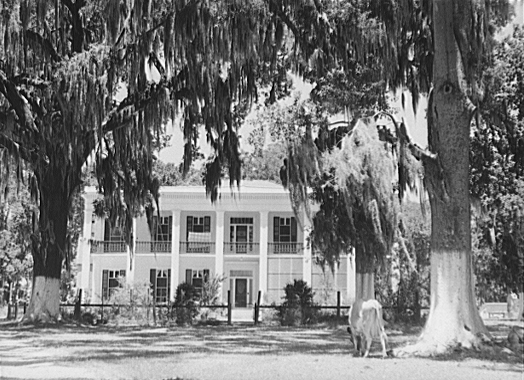
Jackson Plantation Home, Schriever, Louisiana, Photograph by Marion Post Wolcott for Farm Securities Administration, Library of Congress
What about honor as an alternative cause of the war? While no one would argue that honor isn’t a good thing, it’s a vague concept to cite as the primary cause of a war without more context. Disputes about honor are a result rather than a cause of disagreements. Once the disagreement turns into a war, both sides are always more “honorable” than the other side in their own minds. Having said that, there was a distinctive code of honor in the South that could be described, depending on one’s point of view, as either thin-skinned or chivalrous in the knightly sense of the word. The most popular southern author was Sir Walter Scott, a Romantic Scottish writer whose best-known work Ivanhoe (1819) depicts an honorable 12th-century Saxon stand against Norman tyranny. Had Braveheart (1995) been around then, it would’ve been a hit south of the Mason-Dixon Line. Southerners saw Yankees as tyrannical, undignified money-grubbers while Northerners saw southern elites as haughty and quick to take offense. Everyone thinks they have honor and their adversaries don’t, and these tensions mounted over the course of the 1850s as commentators and politicians on both sides exchanged insults. Imagine if the sort of red-blue partisanship and “culture wars” we have today broke down purely along regional lines. The mood worsened considerably after John Brown’s failed raid in 1859 when some southern congressmen even advocated a shoot-out on the House floor.
Whatever honor means, in order to be a meaningful cause of the Civil War it would have to be a type specifically violated by Lincoln’s election, because that’s what triggered secession. Or, at least Lincoln’s election would have had to have been the proverbial straw that broke the camel’s back. What was it about Lincoln that made people fight to defend the “southern way of life?” The same goes for any other explanation, insofar as one has to connect back specifically to November 1860. In matters like this, chronology, context, and timing matter. What stands out about Lincoln? Many things, including his height and stovetop hat, but his distinguishing characteristic was that he was the first president in American history to oppose slavery, or at least its expansion. It would’ve been quite a coincidence for half the country to leave the U.S. upon Lincoln’s election if their reason hadn’t concerned this controversial and groundbreaking stance, especially given the huge economic implications of abolishing slavery.
It makes sense, though, that Lincoln’s views on slavery may have violated some Southerners’ code of honor. One South Carolina family conveyed that sentiment as they sent four sons off to fight: “We…are contending for all that we hold dear — our property — our institutions — our honor…I hope it will end in establishing a Southern Confederacy who will have among themselves slavery, a bond of union stronger than any which holds the North together.” Like the economic-differences argument, the honor argument overlaps with slavery, completely so according to this letter. Later, honor connected to the Union army invading the South, as there was honor in defending one’s homeland, but that doesn’t explain secession.
Finally, what about states’ rights? This interpretive bugaboo is the most common if hornswoggling alternative explanation. As of 2011, a Pew poll showed that 48% of Americans (and 60% under age 30) see this as the primary cause of the war, with slavery second at 38%. We’ve seen above that states’ rights is relevant to the issue of secession, the immediate cause of the war. The liberty to join or leave the union at will is undoubtedly the most fundamental of all states’ rights, and once the war started that’s what it was about, especially in the first half, before the Union added abolition to its goals. And states’ rights sentiment had a long tradition prior to the Civil War, especially in the South, dating back to the creation of the national government in 1787. And states’ rights played a prominent role during Reconstruction after the war, as we’ll see in Chapter 22, because the Union Army occupied resistant southern states and tried to impose its will.
But what about the ultimate cause of the war in 1860? Why did the Southern states secede in the first place? Did they secede because the national government was becoming too powerful in relation to the states? This explanation seemingly has some promise, because Lincoln threatened an important right of incoming western territories. He rejected their right to legalize slavery, and it was during the territorial phase that territories drew up their future state constitutions. 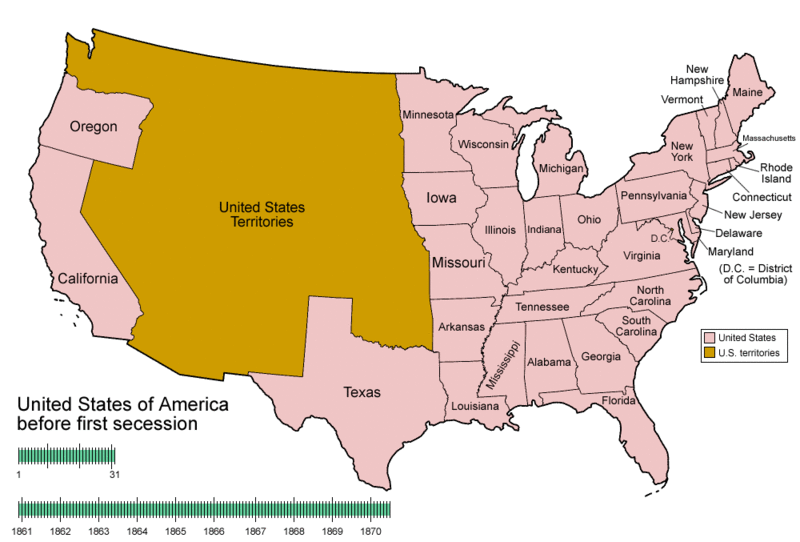
But here’s the kicker: Confederates opposed the right of those same western territories to outlaw slavery. Here they agreed with Lincoln’s policy of the national government dominating the territories as they wrote up their state constitutions, except that they thought the national government should require that slavery be legal rather than illegal. Despite their many disagreements, Southern Confederates and Lincoln were in agreement that new states shouldn’t be empowered to decide for themselves on the contentious slavery issue. The only presidential candidate in 1860 that put a premium on states’ rights was Stephen Douglas of Illinois since he favored free sovereignty in the territories that were about to become states (see Douglas’ Freeport Doctrine). Unsurprisingly, he got zero southern electoral votes. The reason is that Confederates didn’t genuinely care about states’ rights or, if they did, it was easily, if subconsciously, usurped by their concern for preserving slavery. John Breckinridge, the southern Democratic candidate, had been a big supporter of Douglas’ free sovereignty idea in 1854 and continued to support territorial rights as VP under Buchanan. But Southern Democrats broke away in 1860 after Douglas refused to endorse a plank to their platform legalizing slavery outright in all territories, as ruled in Dred Scott. New Mexico and Utah had banned slavery during their territorial phases but, in order to prevent that from happening again, Jefferson Davis argued that the national government should buttress the Dred Scott ruling by reinforcing it with a federal slave code out west. By pushing too hard for a national slave code in their 1860 convention, they alienated northern Democrats who left the party because they supported states’ rights, paving the way for a Lincoln GOP victory by splitting the Democratic vote. When the southern faction nominated Breckinridge as their candidate, he had no choice but to abandon his commitment to free sovereignty and, by extension, states’ rights. The 1860 Democratic Convention provides a perfect litmus test for anyone questioning the Confederates’ priorities on the eve of the Civil War. Not only is the states’ rights theory malarkey, the very reason Southern Democrats broke away was their opposition to states’ rights on the issue that mattered most to them: slavery.
Like the Confederates-to-be, Lincoln also favored a blanket ruling for new western territories. At that point, the problem with the GOP wasn’t that it undermined southern states’ rights, but rather that its version of northern nationalism conflicted directly with southern nationalism. Then, and only then, did southerners use states’ rights to underpin the legality of secession by emphasizing the voluntary compact aspect of the original union. Tellingly, when the Confederacy wrote its own constitution, they didn’t give their states the right to decide slavery on their own; their national government mandated that it be legal everywhere (Article IV). If states’ rights were really more important to the Confederacy’s founders than slavery, then why not leave the slavery question to their own states? Finally, once war broke out, the Confederacy didn’t honor Missouri or Kentucky’s right to determine on their own whether or not they wanted to join the Confederacy or Union, attempting to take both by force.
In his Devil’s Dictionary, Ambrose Bierce described politics as “a strife of interests masquerading as a contest of principles.” Anyone whose judgment isn’t clouded by an emotional stake in the matter can see that the South’s passion for the principle of states’ rights was inspired mainly by, and limited to, their economic interest in slavery or defense of secession. Given Bierce’s background as a Union soldier and engineer who fought at Shiloh and Kennesaw Mountain, that very example might have inspired his cynical definition of politics.
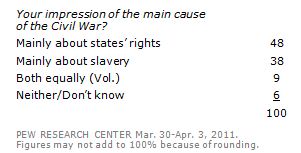 You don’t have to inquire far to see that very few of us, save a handful of legal scholars, have much genuine concern for actual constitutional principles, and few did in 1860 either. For the vast majority, states’ rights is the sort of principle one employs only selectively as a means to an end, similar to one’s opinions on executive orders or judicial activism. To be sure, there are a few Tenth Amendment purists here and there who favor the amendment granting all powers not enumerated in the Constitution’s text to states. Such arguments and controversy could scarcely be avoided in a federal system designed to share and distribute power at multiple levels. But does anyone care passionately enough about centralization versus decentralization in their own right to fight a war over it? That war probably would’ve been fought in 1787-90, if ever, between Federalists and Anti-Federalists. Texans were familiar with a more recent struggle against centralized Mexican authority from the 1830s, but slavery was also one reason for their fight against Mexico, as we saw in Chapter 17.
You don’t have to inquire far to see that very few of us, save a handful of legal scholars, have much genuine concern for actual constitutional principles, and few did in 1860 either. For the vast majority, states’ rights is the sort of principle one employs only selectively as a means to an end, similar to one’s opinions on executive orders or judicial activism. To be sure, there are a few Tenth Amendment purists here and there who favor the amendment granting all powers not enumerated in the Constitution’s text to states. Such arguments and controversy could scarcely be avoided in a federal system designed to share and distribute power at multiple levels. But does anyone care passionately enough about centralization versus decentralization in their own right to fight a war over it? That war probably would’ve been fought in 1787-90, if ever, between Federalists and Anti-Federalists. Texans were familiar with a more recent struggle against centralized Mexican authority from the 1830s, but slavery was also one reason for their fight against Mexico, as we saw in Chapter 17.
As you can hear in the podcast from University of Texas professor George Forgie at the end of the chapter, saying that you’d fight for states’ rights is like saying that the underlying reason you are divorcing your spouse is that divorce is legal in your state. It leaves out the root cause of the breakup. Likewise, interpretations ignoring or downplaying slavery as the ultimate reason for secession — focusing instead on the right of states to secede — are essentially arguing that southern states seceded because of their constitutional right to secede. The Confederate statue on the capitol grounds in Austin says that Texas rebels died for states’ rights. Which ones?
Presumably either the right of states to legally practice slavery or to leave the Union if the national government threatened that right. If that’s not the case, then the people who erected this statue did its honorees a disservice by not clarifying their cause more clearly.
To illustrate how vacuous the stand-alone states’ rights argument is as a cause of the Civil War, imagine the following scenario: what if Chief Justice Taney had taken things a step further in Dred Scott v. Sandford (1856) and ruled not only that no western territory had the right to restrict slavery because doing so violated the Fifth Amendment right to own property, but also neither did any existing state? Would eleven southern states have gone to war to break away from the U.S. to protest that case — because an overbearing national government was violating the right of states to restrict slavery? Would thousands of Confederate soldiers have risked their lives out of concern that states were losing their right to ban or abolish slavery within their jurisdictions? It beggars belief to imagine that happening.
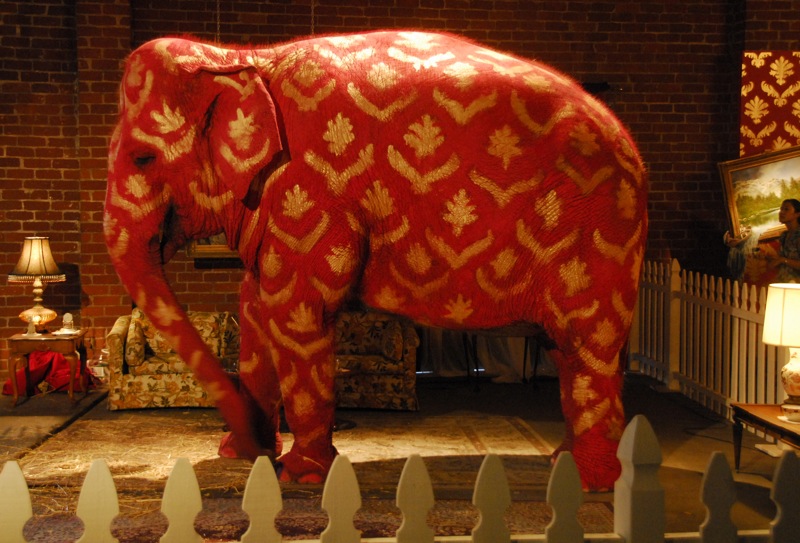 While states’ rights wasn’t a cause of the war, secession itself directly concerned the right of states to leave the nation. After the war, Confederates continued to beat the states’ rights drum as a way to downplay their dedication to a cause that already seemed embarrassing even a few short years after emancipation. The Reconstruction era was fertile ground for that interpretation because there was tension between the national government and southern states over Union Army occupation and the legality of southern states denying rights to their own citizens. That fight led directly to the Fourteenth Amendment, whereby states are obligated to honor (incorporate) most of the Bill of Rights within their own jurisdictions. The Fourteenth undermined the right of states to discriminate against targeted members of their populations.
While states’ rights wasn’t a cause of the war, secession itself directly concerned the right of states to leave the nation. After the war, Confederates continued to beat the states’ rights drum as a way to downplay their dedication to a cause that already seemed embarrassing even a few short years after emancipation. The Reconstruction era was fertile ground for that interpretation because there was tension between the national government and southern states over Union Army occupation and the legality of southern states denying rights to their own citizens. That fight led directly to the Fourteenth Amendment, whereby states are obligated to honor (incorporate) most of the Bill of Rights within their own jurisdictions. The Fourteenth undermined the right of states to discriminate against targeted members of their populations.
Economic differences, honor, and states’ rights, then, are all roundabout ways of talking about complications arising from slavery. Don’t get bamboozled. No major non-slavery-related economic or states’ rights controversies had anything to do with the Civil War. Americans and education boards hide behind complexity as a way to avoid the proverbial elephant in the room. When historians point to slavery as the cause of secession, they’re not talking about the physical act of harvesting cotton or sugar; they’re taking slavery’s broader economic, social, religious, and political implications for granted.
Confederates Explain Their Cause
It’s always best, wherever possible, to let historical actors speak for themselves. Luckily, we have excellent primary source evidence at our disposal to help us get to the bottom of the Civil War’s causes. Let’s look at secession’s ringleader, South Carolina, and their 1860 Declaration of Causes, or Declaration of Secession. Did they have a problem with states’ rights in 1860? They sure did. States had too much power, according to them, insofar as northern states were defying the “General Government” by not complying with the Fugitive Slave Clause. Strengthening the Fugitive Slave Clause in 1850 was one of the strongest expressions of national power in American history up until then. It authorized the military and bounty hunters to run roughshod over unwilling Northerners, whose own appeals to states’ rights fell on deaf ears. When it came to restrictions against harboring runaway slaves, South Carolina favored big government over states’ rights, but they supported states’ rights elsewhere in their 1860 Declaration of Causes. The first ¾ or so of the document discusses the relationship between the states, and between the states and national government in more general terms but, toward the end, it gets to why states’ rights were back on the table for the South. The state’s political leaders believed, accurately enough, that the incoming president’s (Lincoln) plan was to “put slavery on the path to ultimate extermination,” a suspicion confirmed by later events. Lincoln had used those very words in speeches, dating back to 1858. They also criticize what they saw as the erroneous religious beliefs supporting abolition that had taken root in the North, captured in this Uncle Tom’s Cabin painting:
South Carolina wasn’t the only state to draw up a declaration of secession. Louisiana didn’t beat around the bush in speaking for the others: “The people of the slaveholding states are bound together by the same necessity and determination to preserve African slavery.” These declarations, all based on the Declaration of Independence, are surely the best source out there regarding the causes of secession because Confederate leaders took the time to clarify their positions publicly. Can you imagine if we tried to understand why American colonists broke from Britain by ignoring Jefferson’s 1776 Declaration? The following group Ordinance links to fleshed-out explanations by South Carolina, Mississippi, Georgia, and Texas. Texas complains that the government hasn’t sufficiently protected them from Indian attacks — echoing Jefferson’s complaints against Britain in the Declaration of Independence — and “forays of Mexican banditti,” but doesn’t explain why leaving the country would offer them more protection or why this was suddenly a bigger issue once Lincoln was elected. The national government, after all, wasn’t prohibiting Texas from doing whatever it could at the state level to fight Indians. Why did Texas leave the United States? According to Confederate Texans, because northern states “demand the abolition of negro slavery throughout the Confederacy.”
Three states mention the breakdown in justice after the John Brown Raid, when Iowa and Ohio harbored fugitives involved in the raid, illegally refusing to turn them over. Here again, southern states complained about states defying the national government. But more noteworthy is how alienated the South was at the new regional party system, with Republicans purely in the North. Arkansas, for instance, points out that a northern party had come into power (the GOP) that didn’t really even exist in their state, echoing their resolution from a month earlier when they’d declared their opposition to a party whose controlling idea was “hostility to African slavery.” While the trunk ordinance beats around the bush with a lot of legal jargon, the individual manifestos make no bones about preserving slavery as their cause for leaving the Union. There are various complaints, to be sure, but defending slavery is their prevailing theme and common denominator. The rest is seasoning and side dishes. Mississippi writes, “Our position is thoroughly identified with the institution of slavery — the greatest material interest in the world.” Georgia cites “numerous and serious complaints against non-slaveholding states with reference to the subject of African slavery.” Texas proclaims that the “servitude of the African race to the white” was a condition her citizens “intended to exist in all future time.” The people trying to “rewrite history” and “rob us of our heritage” are the cherry-pickers that left that off the plaque at the Capitol statue.
For Confederate leader Jefferson Davis, the exclusion of slavery from the territories threatened to make “property in slaves so insecure as to be comparatively worthless” (Message to CSA Congress, 4.29.1861). His home state of Mississippi was on the verge of losing one of its most cherished rights as a state: that of excluding Blacks from their interpretation of the Declaration’s all men are created equal phrase (see paragraph 8). Even after the war, when Davis changed his mind and spun an interpretation minimizing slavery, his discussion of states’ rights always wound back to the right of states to maintain slavery. The same slavery-obsessed dialogue had been going on throughout the Sectional Crisis, dating back to the Mexican War. Georgia Supreme Court Judge Henry Benning advocated a “consolidated republic” as early as 1849, in order to put slavery directly under the control of those with a stake in it. Said Benning of the slippery slope of abolition: “Is it supposed that the white race will stand for that?… We will be overpowered and our men will be compelled to wander like vagabonds all over the earth, and as for our women, the horrors of their state we cannot contemplate in imagination.” Through 2023, Fort Moore was named Benning to honor his service as a Confederate general. Ten American military forts were named for Confederates who fought against the United States.
Archivists have also compiled newspaper editorials from across the South explaining the secessionist cause. They, too, point to slavery’s preservation. The same Charleston Mercury that assured its readers in 2011 that the Civil War wasn’t about slavery, said this in 1860 when owned by leading Fire-Eater Robert Rhett: “The issue before the country is the extinction of slavery…No man of common sense, who has observed the progress of events, and is not prepared to surrender the institution, can doubt that the time of action has come — now or never.” Fellow Fire-Eater William Lowndes Yancey, the “orator of secession,” led the southern defection from the Democratic Party at the Charleston convention in 1860. Together, the declarations and Fire-Eater editorials are a damning argument against those who deemphasize slavery’s role in the conflict. Southern politicians of the mid-19th century were at least refreshingly straightforward about their pro-slavery stance, especially in comparison with post-war defenders of the Confederacy.
Dwight Pitcaithley, former Chief Historian of the National Park Service, has gone beyond the secession declarations and newspapers and analyzed the minutes and amendment proposals of Confederate legislatures along with the commissioners sent out to convince other southern states to secede. It’s a dramatic illustration of the difference between research based on primary source evidence and popular mythology. Based on a quantitative analysis of these proceedings, instead of states’ rights, honor or economic differences, he ranks their concerns as follows:
1. The extension of slavery into western territories.
2. Complaints over the unwillingness or inability of northern states to turn over fugitive slaves.
3. Complaints that slaveowners couldn’t take slaves into Washington, D.C. and free states for as long as they chose if they called them “sojourns.”
4. Tariffs.
Let’s remember that, in 1860 dollars, there was $3-4 billion worth of enslaved human beings in the South. Just to put some perspective on the cotton industry, the total invested in these workers and cotton was bigger in 1860 than all of the railroads, farms, and factories of the North combined. A southern politician or businessman would’ve been a real scholarly fellow indeed to care more about constitutional theory than slavery, especially if it was “the greatest material interest in the world.”
Why Soldiers Fought
The causes of the Civil War we’ve spoken of so far are why Confederate politicians chose to leave the U.S. and why Republicans chose to block them. We’re not generalizing about what motivated individual soldiers or citizens. There’s a big difference because common peoples’ reasons varied widely. Many Union soldiers disliked Blacks and some had owned enslaved workers. Few Confederate soldiers owned enslaved workers, including those memorialized on the Texas Capitol statue that explains “Why They Fought.” Confederate General Robert E. Lee was a lukewarm supporter of slavery and hoped that God would eventually abolish it after Lee was done profiting from it. Union General William Tecumseh Sherman, who lived in the South but opposed secession, was likewise a lukewarm slavery supporter, agreeing with Lee that it at least benefited Africans. Among the soldiers and generals, we can genuinely say that motivations for fighting in the Civil War were complicated.
Many soldiers on both sides fought for God; others joined the army out of boredom; some joined up to impress a girl. Your author’s great-great-grandfather, John Strange, is a case in point. His writings don’t mention slavery, Unionism, Lincoln, tariffs, wage labor, or abolition — just a conversation his family had in April 1861 about a neighbor who shot his own foot to avoid serving. John’s wife said that she’d rather lose a husband than be married to a coward and he enlisted the next day.
Similar reasons prevailed among soldiers on both sides of the line. Some poor white Southerners dreamed of owning enslaved workers, defending the institution the same way a working-class lottery ticket buyer today would defend low taxes for the rich. Southern citizens were also more likely to have a genuine adherence to states’ rights than their leaders since it was a common sentiment in both the North and South. Sometimes leaders employ such arguments as a means to an end, but citizens take the idea to heart in a more meaningful way, and many wouldn’t have known about the Confederate leaders’ hypocrisy on the issue. As we saw way back in our discussion of the Whiskey Rebellion in the 1790s, early Americans were almost self-selected for rebellion against centralized authority, be it from London or Washington, with many having emigrated from the British Isles for more freedom. That was true enough of the many Scotch-Irish in the Confederacy. And as we’ll see in the next chapter, the Confederate government struggled to maintain authority over its states once the war began, politically and militarily. Likewise, unlike their leaders, some Northerners fought for abolition from the outset.
After the war began, many Southerners fought in self-defense since the Union Army invaded their region. There’s a telling scene in Ken Burns’ Civil War documentary (1989) when Memphis writer Shelby Foote recounts the story of a Confederate that Union soldiers passed along the road. When the Blues asked him why he was fighting he simply said, “Because, you’re here.” Historian Ashley Cruseturner writes that many Confederates fought for “home and kin and survival and the fellow alongside him in the trenches as well as, paradoxically, the seemingly very ‘American’ prerogative to conduct your affairs independently — even when in the wrong.”
 In his classic memoir “Co. Aytch,” Maury Grays, First Tennessee Regiment (aka Side Show of the Big Show), Samuel Watkins (left) wrote that the Confederacy fought for states’ rights and doesn’t mention slavery. By the time he wrote it, he’d had time to marinate in 20 years of post-war revisionism. But also remember that, by the time he saw action, the CSA really was fighting for the right of states to leave the country.
In his classic memoir “Co. Aytch,” Maury Grays, First Tennessee Regiment (aka Side Show of the Big Show), Samuel Watkins (left) wrote that the Confederacy fought for states’ rights and doesn’t mention slavery. By the time he wrote it, he’d had time to marinate in 20 years of post-war revisionism. But also remember that, by the time he saw action, the CSA really was fighting for the right of states to leave the country.
Regardless of whether or not they supported slavery, and some didn’t, most Southerners naturally felt defensive once the war got going, especially when the Union shifted toward more scorched Earth tactics from mid-1863 on, such as Grant’s Vicksburg Campaign and Sherman’s March through Georgia. But whatever their views on slavery, most at least saw it as an institution that kept a large and threatening black population in line. In other words, slavery was essential to maintaining social order. They looked, for instance, at Nat Turner’s Revolt in Virginia in 1831, when enslaved rebels killed 60 Whites with machetes. What would millions of free Blacks do to Whites if they were ever freed? And, as we saw in previous chapters, black subordination became a fallback source of pride and honor among poor white Southerners.
Finally, another factor that compelled many to fight was simple coercion. By 1863, both sides were drafting most of their soldiers into service and many were afraid they’d be shot if they were caught deserting. Even at the beginning of the war, though, the majority of soldiers on both sides probably weren’t fighting mainly either for or against slavery. Most Confederates were fighting for their region and most in the Union were fighting for just that: union.
It’s interesting to study why soldiers fight, but keep in mind that their motivations don’t provide a historical explanation for why wars happen in the first place. Modern Confederate sympathizers sometimes argue that, since an ancestor who fought in the Civil War didn’t own slaves, the war couldn’t have been about slavery. That’s based on the false premise that the motivations of individuals fighting in a war match those of the political leaders who are enlisting them to fight (see Rear Defogger #5 in the tab above). The fact that Confederate soldiers didn’t fight for slavery doesn’t mean that Confederate politicians weren’t having those soldiers fight to protect slavery. Once both sides ran out of volunteers and turned to conscription, then the soldiers’ motivations had even less to do with the political leaders or the war’s ultimate causes.
In this case, critics also suggest that common soldier narratives like Watkins’ were forged as a ploy to divert attention from the Civil War’s real causes. As for some Americans’ ongoing reluctance to understand that Confederate leaders fought to defend slavery, there’s probably a silver lining in this cloud of denial. Mainstream Americans have condemned slavery outright and that rejection is behind their rejection of slavery’s involvement in the war; that’s why they’ve cut that out of the scrapbook and flushed it down George Orwell’s memory hole. Make no mistake, the editorial staff running the Charleston Mercury in 2011 condemned slavery. While abolitionists were a minority in antebellum America, their views are nearly universally accepted at the beginning of the 21st century, even among the CSA’s latter-day Neo-Confederate fans.
Southern Nationhood
Let me show the reader some mercy and end this long-winded diatribe so we can return to 1860 and see how Secession Winter unfolded. We’ll flog the interpretive horse some more when we get to Reconstruction. The Confederate States of America established its first capital in Montgomery, Alabama. You can still claim citizenship in the CSA today, an “occupied government” that condemns violence against any race. They wrote up a constitution very similar to the U.S. version except for its permanent legalization of slavery (Article IV) and outlawing of tariffs (Article 1-Section 8). As mentioned, they denied their states the right to decide slavery on their own. Per their longstanding dispute with the North over tariffs, the CSA included a commitment to free trade in their founding document. 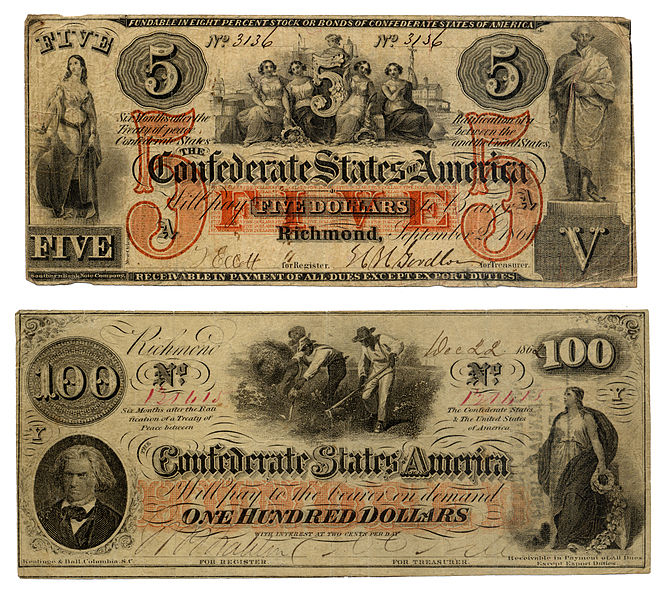
The famous “Stars & Bars” that is controversial in modern times wasn’t the original Confederate banner, but rather the battle flag of Robert E. Lee’s Army of Northern Virginia. The first Confederate flags were variations of the three below on the upper left and bottom row, with the familiar Stars & Bars on the upper right.
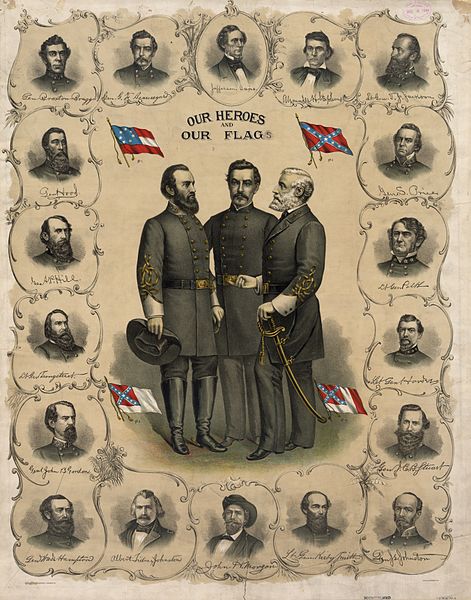
Color Lithograph From 1896 Showing Four Versions of the Flag of the Confederate States of America, Library of Congress
It’s telling that the CSA chose red, white, and blue for their flag and included Founders like George Washington on their money because they considered themselves the real America. In many ways they were. An unlikely alliance of 19th-century Confederates and 21st-century progressives agree that they represented true U.S. history at least as well their northern counterparts. Their name, the Confederacy, evoked the United States’ first government, the Confederation Congress that operated under the Articles of Confederation (1781-89). The enslaved workers, also depicted on Confederate money, built much of early America and slaveholders founded America. Confederates understandably saw themselves as the rump state and the North as the new revolutionaries breaking away. Of course, rump states would normally be the ones operating within the established constitutional framework rather than breaking away or committing treason against it. But for Confederate leaders, abolishing slavery would reverse the revolution of 1776 by denying property rights. After the Upper South seceded, the CSA hoped to coax Pennsylvania and New York into joining them, to isolate New England. New York considered secession, but only to start its own country called Tri-Insula (for Manhattan [island], Long Island, and Staten Island) that would continue to import cotton rather than to actually join the Confederacy or stay loyal to the Union.
In keeping with their centrist American spin, the CSA nominated a moderate as their president rather than a rabid pro-slavery Fire Eater: Mexican War hero, Secretary of War, and Senator Jefferson Davis of Mississippi. Davis was an old friend of Abraham Lincoln’s but became the leader of the southern senatorial faction after the death of John C. Calhoun in 1850 (also pictured on CSA money). Many Southerners were genuine in their belief that slavery was a benevolent institution, as are many of today’s neo-Confederates, despite undeniable historical proof to the contrary. Davis came by that notion honestly because, on the Mississippi cotton plantation where he grew up, his parents purportedly treated their workers with as much kindness and respect as possible given the circumstances. After the war, Davis wrote that enslaved workers “increased from a few unprofitable savages to millions of efficient Christian laborers. Their servile instincts rendered them contented with their lot…Never was there a happier dependence of labor and capital upon each other.” To Southerners, slavery in its most idealized form imbued its masters with a sense of paternalism they felt was lacking in the money-grubbing North, where management didn’t look out for miners or factory workers. To that end, Davis was a fitting leader of the new nation because he genuinely didn’t grasp the downside of slavery in all its forms and considered the institution “a blessing.” Well into the 20th century, Alabama textbooks taught students that slavery was an early form of Social Security. What wasn’t fitting about Davis as the CSA’s leader was that he opposed secession, at least up until the last moment. He agreed with Calhoun, though, that slavery was the key to white dignity. Said Davis:
“I say that the lower race of human beings that constitute the substratum of what is termed the slave population of the South, elevates every white man in our community … It is the presence of a lower caste, those lower by their mental and physical organization, controlled by the higher intellect of the white man, that gives this superiority to the white laborer. Menial services are not there performed by the white man. We have none of our brethren sunk to the degradation of being menials. That belongs to the lower race—the descendants of Ham.”
For their VP, the Confederacy nominated another old Lincoln acquaintance, Alexander Stephens of Georgia. Stephens was more open about Confederate aims than Davis, who after the war seemed to think that Blacks enjoying slavery sufficed as a counter-argument to the idea that secession had anything to do with slavery (if anything, Blacks enjoying slavery, in combination with Whites profiting from it, would make the institution even more worth defending, making it even more likely to have been the cause of the war). Two months after Davis’ Farewell Address to the U.S., Stephens called slavery the “immediate cause of the late rupture and revolution,” agreeing, on that, with Lincoln. His problem with the U.S.? It was founded on the false premise that all men are created equal and that slavery eventually would (and should) die away. “This was an error.” Conversely, the Confederacy said Stephens: “is founded upon exactly the opposite idea; its foundations are laid, its cornerstone rests, upon the great truth that the Negro is not equal to the white man; that slavery, subordination to the superior race, is his natural condition. This our new Government, is the first, in the history of the world, based on this great physical, philosophical, and moral truth…It is upon this, as I have stated, [that] our social fabric is firmly planted.” CSA General Nathan Bedford Forrest was less verbose, stating, “We’re fighting to keep our [N-word]s.” Forrest went on to lead the Ku Klux Klan after the war. Unless the Confederacy’s vice-president was completely out of touch with his own government, Stephens’ “Cornerstone Speech” contradicts the notion that the CSA didn’t break away from the U.S. to defend and perpetuate slavery. And you can see why Thomas Jefferson wasn’t real popular on either side of the Mason-Dixon Line in the Civil War era, given his infamous flip-flop on slavery and inspirational words in the Declaration. Historian Ibram X. Kendi described Jefferson “as both the inspirational relative and ideological enemy of the Confederacy.”
Did the South fight for white supremacy? No, that would’ve been impossible at the time because it wasn’t a contested issue; the North already adhered to white supremacy. But the Confederate government, regardless of what their rank-and-file soldiers or citizens thought, made a hasty and ill-advised decision to fight for slavery. Lincoln drove a hard bargain against slavery’s western expansion combined with a generous offer to allow southeastern slavery in perpetuity. Instead of calling his bluff, Confederates overreacted and overestimated their own strength (as prophesied by Sam Houston) and European dependence on their cotton exports. As we’ll see in the next chapter, secession ironically destroyed American slavery altogether.
Lincoln’s “Last, Best Hope Of Earth”
Was Lincoln fighting to free the people that Forrest wanted to keep enslaved? It wasn’t his top priority. It’s true he loathed slavery, often challenging its advocates to try it for a while if they liked it so much. But Lincoln’s overriding concern in 1861 was to preserve the Union at any cost, including acquiescing in southern slavery and enforcing the Fugitive Slave Act. As late as August 1862, Lincoln wrote Horace Greeley: “If I could save the Union without freeing any slave I would do it, and if I could save it by freeing all the slaves I would do it.” The “Great Emancipator” didn’t set out to be and assumed that the South would come to their senses and compromise. After all, they easily could’ve avoided war and kept slavery. That’s why Lincoln offered to back the amendment legalizing slavery where it already existed. Was he bluffing? Lincoln went far enough out on a limb that he would’ve been forced to go along with it. It’s a tough pill to swallow for some Northerners reared in the mythology of the “Battle Cry for Freedom,” but the Civil War only morphed into an abolitionist cause midway through, and many people were ambiguous about it even then, including Lincoln’s generals. By then (1862-63), abolitionism was defined more radically, as wanting to get rid of southern slavery rather than just stopping its western expansion.
While the CSA’s take on American history ran through the Constitution and the Founders as slaveholders, Lincoln’s ran through the Declaration of Independence and the idea that slavery was incompatible with its ideals of freedom and liberty. That’s why Lincoln inspired hope in Blacks and fear in Southerners despite his compromised official stance. He saw the South as extorting votes by demanding a pro-slavery national government under threat of leaving the Union. Importantly, Lincoln equated secession with destroying the Union whereas the South saw itself as simply exiting a voluntary compact. In his Second Inaugural Address four years later, Lincoln said, “Both parties deprecated war, but one of them would make war rather than let the Union survive, and the other would accept war rather than let it perish.” Today, those words are etched into the walls of the Lincoln Memorial in Washington. For Lincoln, there was no United States without the Southeast.
In the Cooper Union Speech, Lincoln said that the secessionist demand “could scarcely be distinguished in principle from that of a robber.” History itself was being stolen, along with U.S. property. What about all the military installations in the South? Hadn’t Americans, as a group, paid for them and fought for them together in the Revolution, War of 1812, and Mexican War? The South offered compensation but Lincoln wasn’t selling. For him, that would’ve been like baking a cake for 85 years then trying to remove the eggs and sugar. The American cake was already baked. While the Confederacy offered up learned theoretical arguments as to why secession was legal and constitutional, Lincoln’s true focus wasn’t on the Constitution so much as keeping the U.S. intact no matter what. The struggle presented “to the whole family of man, whether or not a constitutional republic can or cannot maintain its territorial integrity against domestic foes.” Lincoln saw secession as on the slippery slope to anarchy.
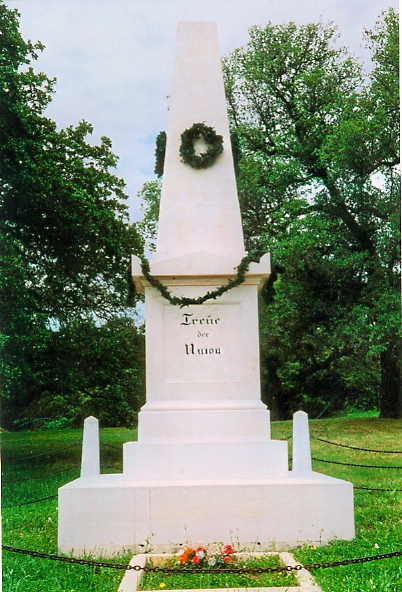
1866 Treue der Union Monument, Comfort, TX, Honoring German-American Unionists Killed By Confederates In 1862 Nueces Massacre
The whole family of man phrase is key to understanding Lincoln’s position and why he differed from the millions of Northerners who said “good riddance…let the South go.” Regarding the question of the constitutionality of secession, the Detroit Free Press opined: “If tyranny and despotism justified the Revolution of 1776, then we do not see why it would not justify the secession of Five Millions of Southrons from the Federal Union in 1861” (Feb. 19, 1861). But Lincoln saw America in an international perspective, calling the U.S. the “last, best hope of Earth” for representative government. History rarely proceeds uniformly and republicanism was waning in the mid-19th century. In the years after the American Revolution, democracy seemed to be the wave of the future, manifested most dramatically in the French Revolution of the 1790s. But France degenerated into a dictatorship even as it knocked off other monarchies across Europe, and Europe as a whole reverted in a conservative direction after 1815. There was another wave of democratic uprisings in 1848, including one in France, but even those that initially succeeded sputtered by the 1850s. One reason the German-Americans in the Texas Hill Country were so devoted to Lincoln and the Union was that they’d emigrated after having failed to bring about democracy in Germany.
How many significant democracies were left in the world in 1861? The answer is roughly about as many as there are communist governments today – a movement most of us consider to have been virtually dormant since the Cold War ended and the Soviet Union collapsed in 1991. Today there are communist regimes in North Korea, Laos, and Cuba (except for small stores), and single-party planners control more open markets in Venezuela, Vietnam, Myanmar, and China. In 1861, there were three major republics in the world — the U.S., Mexico, and Switzerland, with Canada six years from gaining independence — and Lincoln was presiding over the biggest. Like communism today, most serious observers thought democracy circa 1860 had already been consigned to the graveyard of bad ideas. That’s why Lincoln called America the “last, best hope of Earth” for salvaging republicanism. Moreover, he saw slavery as making Americans hypocrites in the eyes of foreigners, depriving them of being more worthy examples. The last, best hope phrase came in an 1862 State-of-the-Union address concerning the Emancipation Proclamation that triggered abolition.
The Union’s eventual victory in the Civil War is what compelled France to give the U.S. the Statue of Liberty, the parts of which were sent across the Atlantic on a boat and assembled in New York Harbor in the 1880s after being displayed at exhibitions around America and France. At the feet of the assembled “Lady Liberty” are the broken chains of slavery and it’s no accident that the statue faces east, toward Europe. Unbeknownst to most Americans, who identify the statue mostly with immigration because of its proximity to Ellis Island, Lady Liberty is really a Civil War monument and a beacon to future republicans in Europe.
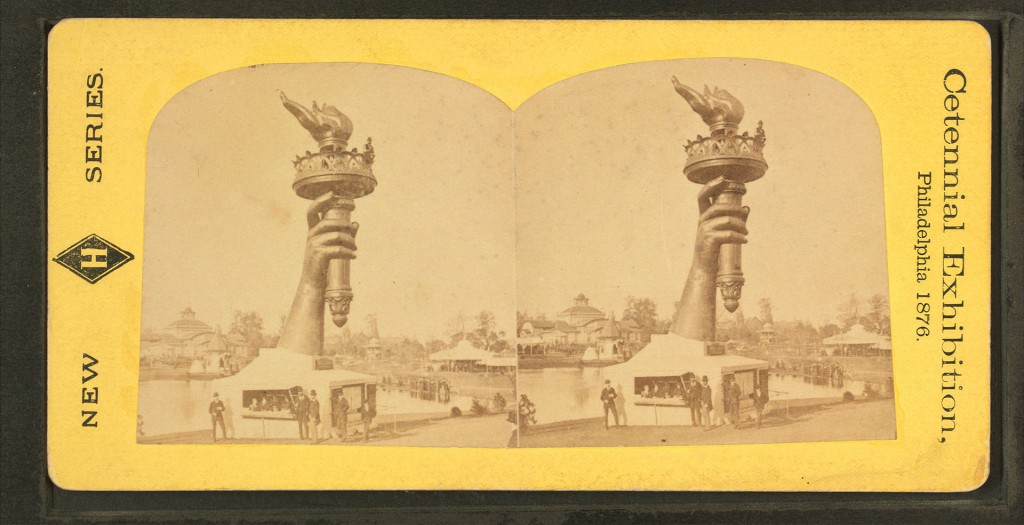
Stereoscopic View of Hand & Torch of Bartholdi’s Statue of Liberty, Philadelphia, 1876, Robert Dennis Collection
Lincoln thought democracy was an experiment worth continuing and resolved to preserve it by keeping the South in the U.S. rather than going forward with a smaller country. Thus ensued what the North called the Civil War because it didn’t recognize the CSA as a new country until 1863, and what the CSA called the Southern War for Independence. Had the CSA won, that’s what we’d call it in history books, as well. The reverse was true of the American Revolution, when the British failed to contain what they hoped would go down as a civic uprising.
Midway through the war, at the dedication of Gettysburg battlefield, Lincoln said the Union fought so that “government of the people, by the people, for the people, shall not perish from the Earth.” The Confederacy’s variation in 1861 could have been so that “the enslavement of black people, by white people, for white people, shall not perish from the Earth.”
Optional Listening & Viewing:
Jefferson Davis, Farewell Address to Congress, January 21, 1861
“Texas Officials: Schools Should Teach That Slavery Was A Side Issue To The Civil War” (Washington Post, 7.5.15)
Confederate States of America (Official Government Website)
Southern States’s Declarations of Secession, 1860-61 (Yale Avalon Project)
The Civil War: 150 Years (National Park Service)
Slavery As A Cause of the Civil War (National Park Service: Lincoln Home)
1861 Secession Debate (C-SPAN, 2011, 50:06)
Disunion: Civil War (New York Times)
James McPherson, The Causes of the Civil War (101:47)
Marc Egnal, “The Economic Origins of the Civil War” (OAH Magazine of History, April 2011 > JSTOR)
Paul Finkelman, “Slavery, the Constitution & the Origins of the Civil War” (OAH Magazine of History, April 2011 > JSTOR)
Gerald Gunderson, “The Origin of the American Civil War” Journal of Economic History, 12.1974 > JSTOR)
Virtual Exhibit: Could the Civil War Have Been Avoided? (College of William & Mary)
Blake Earl, “Why This Hill Country Monument Is the Ideal Civil War Tribute” (Austin Monthly, 7.23.20)
Ashley Cruseturner, “The Strange Career of the Battle Flag of the Army of Northern Virginia” (HNN)
John Savage, “Where the Confederacy Is Rising Again [Texas]” (Politico, 8.10.16)
Mary Akers, “How a Goofy Southern Sitcom Became the Vanguard of the Neo-Confederacy,” (Politico, 7.2.17)
WIll Weissert, “Civil War Lessons Often Depend On Where The Classroom Is” (AP 8.22.17)
Brian Palmer & Seth Freed Wessler, “The Costs of the Confederacy” (Smithsonian, 12.18)
Kerry Leigh Merritt, “The Southern Gap” (Aeon, 2024), Concerning Whether Slavery Was Capitalistic
